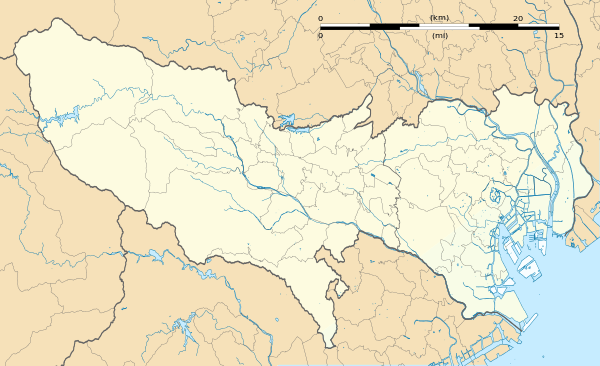Hiroo Station
Hiroo Station (広尾駅, Hiroo-eki) (officially Hiro-o Station) is a subway station on the Tokyo Metro Hibiya Line in Minato, Tokyo operated by the Tokyo subway operator Tokyo Metro. The station is named after the adjacent Hiroo neighborhood in Shibuya ward, though the station is entirely located in Minami-Azabu.
H03 Hiroo Station 広尾駅 | ||||||||||||||||
|---|---|---|---|---|---|---|---|---|---|---|---|---|---|---|---|---|
 Hiroo station entrance 2 in 2005 | ||||||||||||||||
| Location | 5-1-25 Minami-Azabu, Minato, Tokyo Japan | |||||||||||||||
| Coordinates | 35.652188°N 139.722227°E | |||||||||||||||
| Operated by | ||||||||||||||||
| Line(s) | H Tokyo Metro Hibiya Line | |||||||||||||||
| Distance | 17.8 km from Kita-Senju | |||||||||||||||
| Platforms | 2 side platforms | |||||||||||||||
| Tracks | 2 | |||||||||||||||
| Construction | ||||||||||||||||
| Structure type | Underground | |||||||||||||||
| Other information | ||||||||||||||||
| Station code | H03 | |||||||||||||||
| Website | Official website | |||||||||||||||
| History | ||||||||||||||||
| Opened | 25 March 1964 | |||||||||||||||
| Traffic | ||||||||||||||||
| Passengers (FY2016) | 61,620 daily | |||||||||||||||
| Services | ||||||||||||||||
| ||||||||||||||||
| Location | ||||||||||||||||
 Hiroo Station Location within Tokyo  Hiroo Station Hiroo Station (Japan) | ||||||||||||||||
Lines
Hiroo Station is served by the Tokyo Metro Hibiya Line from Kita-Senju to Naka-Meguro, with through-running services to and from the Tobu Skytree Line in the north. The station is numbered "H03", and is 17.8 km from the northern end of the line at Kita-Senju.[1]
Station layout
The underground station consists of two opposed side platforms serving two tracks.
Platforms
| 1 | H Tokyo Metro Hibiya Line | for Ebisu and Naka-meguro |
| 2 | H Tokyo Metro Hibiya Line | for Roppongi, Ginza, Ueno, and Kita-senju TS Tobu Skytree Line for Tōbu-Dōbutsu-Kōen TN Tobu Nikko Line for Minami-Kurihashi |
 Platform 1, looking toward Kita-Senju, in November 2011
Platform 1, looking toward Kita-Senju, in November 2011 Platform 2, looking toward Kita-Senju, in November 2011
Platform 2, looking toward Kita-Senju, in November 2011
Exits
- Exit 1 in November 2011
 The ticket barriers for Exit 1 in November 2011
The ticket barriers for Exit 1 in November 2011 Exit 3 in November 2011
Exit 3 in November 2011 The ticket barriers for Exit 3 in November 2011
The ticket barriers for Exit 3 in November 2011
The station has three exits, numbered 1 to 3. Exit 1 is convenient for visitors to the Arisugawa-no-miya Memorial Park, the Tokyo Metropolitan Library, and the Kitazato Research Hospital. Exit 2 serves those going to the Hiroo shopping arcade, University of the Sacred Heart or the Tokyo Metropolitan Hiroo Hospital. Exit 3 is closest to the International School of the Sacred Heart, Hiroo Gakuen Junior & Senior High School, Japan Red Cross Nursing College or Treatment Center, the Minato Ward Kōryō Junior High School, and the Nishi-Azabu, Minami-Aoyama district.
History
The station opened on 25 March 1964.[1]
Passenger statistics
In fiscal 2016, the station was used by an average of 61,620 passengers daily.[2] The passenger figures for previous years are as shown below.
| Fiscal year | Daily average |
|---|---|
| 2011 | 55,448[1] |
| 2012 | 56,244[3] |
| 2013 | 57,947[4] |
| 2014 | 58,864[5] |
| 2015 | 60,333[6] |
| 2016 | 61,620[2] |
Surrounding area
Hiroo is a desirable upscale residential area with convenient access to a variety of popular areas in Tokyo. It is located on the borders of Shibuya and Minato wards in Tokyo. Hiroo is within walking distance of the nightlife district Roppongi, as well as trendy shopping and dining areas like Ebisu, Azabu Juban, and Daikanyama.
Hiroo is home to many expatriates and professionals working in Tokyo. There are many embassies and several international schools in the area. The German Embassy is a short walk from the station. Hiroo is home to the National Azabu Supermarket, an upscale grocery store which features foreign brands. It closed in October 2011 for rebuilding, and reopened in August 2012.
The Hiroo Shopping street offers a mix of traditional Japanese craft stores and modern boutiques. The Mormon Tokyo Japan Temple is close to Hiroo Station, as is Arisugawa-no-miya Memorial Park. Tokyo Metropolitan Library is located in Arisugawa-no-miya Memorial Park.
References
- Terada, Hirokazu (19 January 2013). データブック日本の私鉄 [Databook: Japan's Private Railways] (in Japanese). Japan: Neko Publishing. p. 215. ISBN 978-4-7770-1336-4.
- 各駅の乗降人員ランキング [Station usage ranking] (in Japanese). Japan: Tokyo Metro. 2017. Archived from the original on 26 July 2017. Retrieved 26 July 2017.
- 各駅の乗降人員ランキング [Station usage ranking] (in Japanese). Japan: Tokyo Metro. 2013. Archived from the original on 1 May 2017. Retrieved 26 July 2017.
- 各駅の乗降人員ランキング [Station usage ranking] (in Japanese). Japan: Tokyo Metro. 2014. Archived from the original on 1 May 2017. Retrieved 26 July 2017.
- 各駅の乗降人員ランキング [Station usage ranking)] (in Japanese). Japan: Tokyo Metro. 2015. Archived from the original on 1 May 2017. Retrieved 26 July 2017.
- 各駅の乗降人員ランキング [Station usage ranking] (in Japanese). Japan: Tokyo Metro. 2016. Archived from the original on 26 July 2017. Retrieved 26 July 2017.
External links
| Wikimedia Commons has media related to Hiroo Station (Tokyo). |
- Official website (in Japanese)